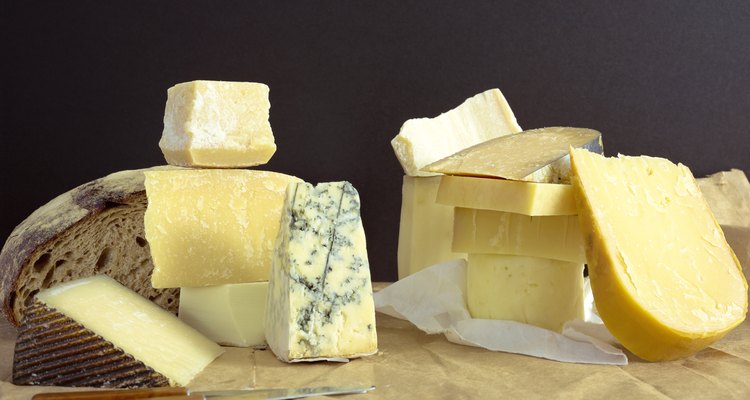
Creatas Images/Creatas/Getty Images
Cheese can be the perfect component to complete your meal or snack. A few ways to use cheese are for cheese plates with grapes, egg white and cheddar cheese breakfast burritos, Swiss cheese and ham sandwiches, Greek salads with feta cheese, pasta with Parmesan cheese and chicken baked with mozzarella cheese. Cheese is a source of many essential nutrients, including high-quality protein, and it can be a regular part of a healthy, balanced diet.
Caloric Content
An ounce of most kinds of cheese has 95 to 120 calories, although feta cheese is slightly lower, with 75 calories per ounce. High-calorie foods, such as full-fat cheese, can lead to weight gain. Monitor your portion sizes and eat them with lower-calorie foods to avoid this. Try shredded Swiss cheese as a topping for onion soup, grated Parmesan in an omelet made with egg whites and a green salad with diced apple and blue cheese.
Fat in Cheese
An ounce of cheddar cheese has 9.4 grams of fat and 6 grams of saturated fat, and an ounce of brie cheese 7.8 grams of fat and 4.9 grams of saturated fat. Saturated fat raises your cholesterol levels, and healthy adults on a 2,000-calorie diet should limit consumption to 20 grams per day. Cheese is among the top sources of solid fats in the typical American diet, according to the 2010 Dietary Guidelines for Americans. Choose reduced-fat dairy products to limit your consumption of saturated fat and calories. An ounce of low-fat cheddar cheese has 2 grams of total fat and 1.2 grams of saturated fat.
Calcium in Cheese
An ounce of cheddar cheese provides 200 milligrams of calcium, or 20 percent of the daily value based on a 2,000-calorie diet. Soft cheese has less calcium per serving, with 52 milligrams in a 1-ounce serving of Brie cheese. Calcium is necessary for maintaining strong bones. Eat your cheese with a source of vitamin D to improve your body’s ability to absorb calcium from the cheese. Choose cheese fortified with vitamin D or have a pizza with cheese and anchovies.
Sodium in Cheese
An ounce of regular cheddar cheese has 247 milligrams of sodium. Most cheese contains sodium because of the salt added during the cheese-making process. Not counting dishes with cheese such as pizza and pasta dishes, cheese provides 3.5 percent of the total amount of sodium in Americans’ diets, according to the 2010 Dietary Guidelines for Americans. A high-sodium diet can increase your risk for heart disease, kidney disease and stroke, and healthy individuals should limit daily intake to 2,300 milligrams per day. An ounce of reduced-sodium cheese has only 4 milligrams of sodium.
Related Articles

Calories in Pimento Cheese

Swiss vs. Cheddar Cheese Nutrition ...
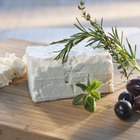
How Many Calories Are in a Goat Cheese ...

How Many Calories in a Taco Bell Bean ...

Nutrition Information on Blueberries
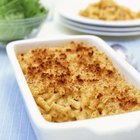
How to Bake Mac & Cheese With a Bread ...
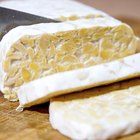
Foods High in Probiotics & Electrolytes

How Fast Does Cooked Spaghetti Squash ...

Can I Exercise on the Master Cleanse ...

How Many Calories in a Cheese Scone?

Calories in One Slice Provolone Cheese

How to Get Rid of Skunk Smell With ...
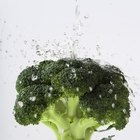
How to Cook a Broccoli and Rice ...
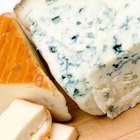
How to Crumble Gorgonzola Cheese

How to Pan-Fry Cheese

Provolone Cheese Nutrition Information
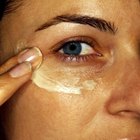
The Best Facial Moisturizer That Won't ...
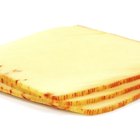
Muenster Cheese Health Benefits

How to Replace Starchy Carbs With ...

Can White Gravy Be Made With Almond ...
References
Writer Bio
Natalie Stein specializes in weight loss and sports nutrition. She is based in Los Angeles and is an assistant professor with the Program for Public Health at Michigan State University. Stein holds a master of science degree in nutrition and a master of public health degree from Michigan State University.
Photo Credits
Creatas Images/Creatas/Getty Images